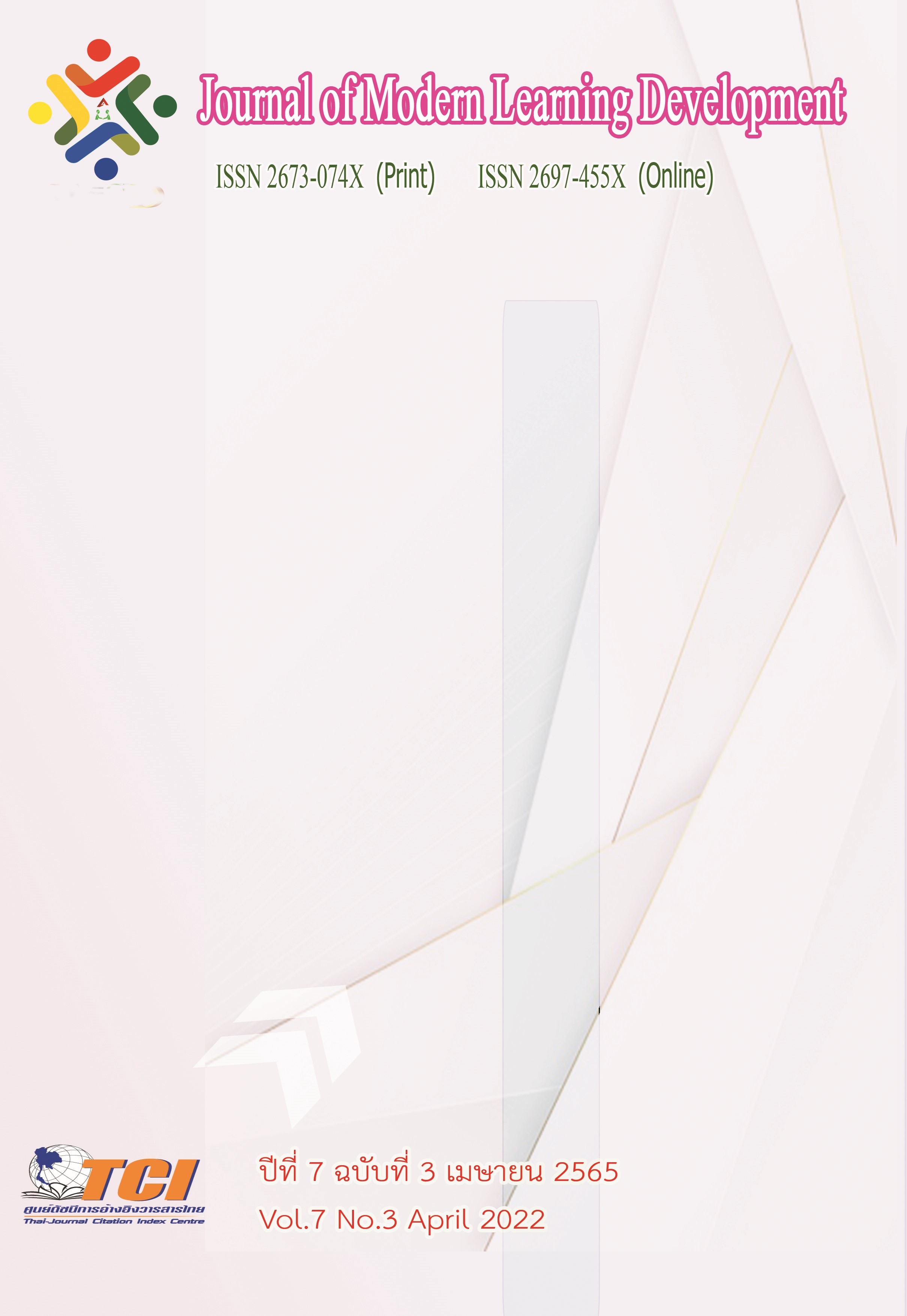การเพิ่มมูลค่าภูมิปัญญาผ้าทอท้องถิ่นสู่การท่องเที่ยวเชิงสร้างสรรค์
Main Article Content
บทคัดย่อ
ภูมิปัญญาผ้าทอท้องถิ่นเป็นสิ่งหนึ่งที่แสดงถึงเอกลักษณ์และคุณค่าต่อสังคม เป็นองค์ความรู้ที่สามารถนำไปพัฒนาท้องถิ่น หากแต่ในปัจจุบันชนรุ่นหลังละเลยภูมิปัญญาที่บรรพชนสรรค์สร้างไว้หันไปประกอบอาชีพอื่นที่มีรายได้แน่นอนกว่า จึงทำให้ภูมิปัญญาผ้าทอท้องถิ่นค่อยๆ สูญหายไป บทความนี้มีจุดมุ่งหมายในการเสนอแนวคิดของการเพิ่มมูลค่าแก่ภูมิปัญญาผ้าทอท้องถิ่นโดยใช้การท่องเที่ยวซึ่งถือเป็นอุตสาหกรรมที่มีรายได้เข้าสู่ประเทศอย่างมหาศาลมาเป็นเครื่องมือ ผ่านการมีส่วนร่วมในกิจกรรมการเรียนรู้ด้วยประสบการณ์จริงที่เรียกว่า “การท่องเที่ยวเชิงสร้างสรรค์” ทำให้คนในชุมชนหันมาให้ความสำคัญ ตระหนักและหวงแหนทรัพยากรทางวัฒนธรรมอันมีค่านี้ไว้ เพื่อสร้างความสมดุลทั้งทางสังคม วัฒนธรรม เศรษฐกิจอย่างยั่งยืนแก่ชุมชนต่อไป
Article Details
เอกสารอ้างอิง
กฤษฎา ศรีธรรมา. (2549). การจัดการความรู้ภูมิปัญญาท้องถิ่นในพิธีสู่ขวัญของชาวอีสาน : รายงานการวิจัย. สำนักศิลปะและวัฒนธรรม: มหาวิทยาลัยราชภัฏมหาสารคาม.
กิตติคุณวัฒนะ จูฑะวิภาต. (2555). ผ้าทอกับชีวิตคนไทย. กรุงเทพมหานคร: โครงการวิจัย มหาวิทยาลัยธุรกิจบัณฑิต .
ทรงคุณ จันทจร, พิสิฎฐ์ บุญไชย, และ ไพรัช ถิตย์ผาด. (2552). คุณค่าอัตลักษณ์ศิลปวัฒนธรรมท้องถิ่นกับการนำมาประยุกต์เป็นผลิตภัณฑ์ท้องถิ่นเพื่อเพิ่มมูลค่าทางเศรษฐกิจและการท่องเที่ยวเชิงวัฒนธรรมภาคตะวันออกเฉียงเหนือ ภาคกลางและภาคใต้. กรุงเทพมหานคร: กระทรวงวัฒนธรรม.
เทิดชาย ช่วยบำรุง. (2554). ภูมิปัญญาเพื่อการพัฒนาท้องถิ่นเชิงสร้างสรรค์. กรุงเทพมหานคร: สถาบันพระปกเกล้า.
พรศรี ดำศรี. (2553). การสืบสานและการถ่ายทอดภูมิปัญญาการทอผ้าไหมของเทศบาลตำบลพุมเรียง อำเภอไชยา จังหวัดสุราษฎร์ธานี. การศึกษาอิสระปริญญารัฐประศาสนศาสตรมหาบัณฑิต. วิทยาลัยปกครองส่วนท้องถิ่น: มหาวิทยาลัยขอนแก่น.
พิริยะ ผลพิรุฬห์. (2556). เศรษฐกิจสร้างสรรค์กับการพัฒนาประเทศไทย. วารสารเศรษฐศาสตร์ ปริทรรศน์, สถาบันบัณฑิตพัฒนบริหารศาสตร์. 7 (1), 1-69.
ภัทรธิรา ผลงาม. (2562). การสร้างมูลค่าเพิ่มจากภูมิปัญญาผ้าขาวม้าในจังหวัดเลยสู่เศรษฐกิจสร้างสรรค์. วารสารวิจัย มหาวิทยาลัยขอนแก่น (ฉบับบัณฑิตศึกษา), สาขามนุษยศาสตร์และสังคมศาสตร์. 7 (3), 146-158.
มูลนิธิสารานุกรมวัฒนธรรมไทย ธนาคารไทยพาณิชย์. (2542). สารานุกรมวัฒนธรรมไทย ภาคใต้ เล่ม 17 : สุบินสำนวนเก่า : วรรณกรรม - หาดใหญ่, อำเภอ. กรุงเทพมหานคร: มูลนิธิสารานุกรมวัฒนธรรมไทย ธนาคารไทยพาณิชย์.
ยุวดี นิรัตน์ตระกูล. (2554). การท่องเที่ยวเชิงสร้างสรรค์: ต่อยอด เพิ่มคุณค่า หาจุดต่าง. ออนไลน์. สืบค้นเมื่อ 8 ตุลาคม 2564. แหล่งที่มา: http://www.etatjournal.com/upload/245/9_CreativeTourism
สำนักงานคณะกรรมการพัฒนาการเศรษฐกิจและสังคมแห่งชาติ. (2552). ออนไลน์. สืบค้นเมื่อ 12 กันยายน 2564. แหล่งที่มา: https://www.doyourwill.co.th/post/creativeeconomy
สิรยา คงสมพงษ์. (2557). รายงานผลสรปุการจัดกิจกรรมการเรียนรู้สำหรับผู้บริหารภาครัฐ หลักสูตรการสร้างมูลค่าจากต้นน้ำถึงปลายน้ำ. กรุงเทพมหานคร: สำนักงานคณะกรรมการข้าราชการพลเรือน.
สุจินดา เจียมศรีพงษ์ และปิยวัน เพชรหมี. (2560). การสร้างมลค่าเพิ่มของผลิตภัณฑ์จากภูมิปัญญาท้องถิ่นไทย: กรณีศึกษาผ้าทอลายโบราณ. Journal of Community Development Research (Humanities and Social Sciences). 10 (4). 62-85.
สุดแดน วิสุทธิลักษณ์ และคณะ. (2556). การท่องเที่ยวเชิงสร้างสรรค์. กรุงเทพมหานคร: องค์การบริหารการพัฒนาพื้นที่พิเศษเพื่อการท่องเที่ยวอย่างยั่งยืน (องค์กรมหาชน).
สุพาดา สิริกุตตา. (2557). แนวทางการสร้างมูลค่าเพิ่มของแหล่งท่องเที่ยวและผลิตภัณฑ์ท่องเที่ยวของจังหวัดสิงห์บุรี ประเทศไทย. วารสารสังคมศาสตร์ มหาวิทยาลัยศรีนครินทรวิโรฒ. 17 (17), 215-230.
องค์การบริหารการพัฒนาพื้นที่พิเศษเพื่อการท่องเที่ยวอย่างยั่งยืน. (2561). คู่มือกระบวนการพัฒนาและยกระดับกิจกรรมท่องเที่ยวเชิงสร้างสรรค์. กรุงเทพมหานคร: บริษัท บุ๊คพลัส พับลิชชิ่ง จำกัด.
Campbell, N. C. G., Graham, J. L., Jolibert, A., & Meissner, H. G. (1988). Marketing Negotiations in France, Germany, the United Kingdom, and the United States. Journal of Marketing, 52 (2), 49-62.
de Chematony, L., Riley, F. D., & Harris, F. (1998). Criteria to assess brand success. Journal of Marketing Management. 14 (7), 765-781.
Dictionaries of Royal Institute. (1999). The meaning of culture. Bangkok: Nanmeebooks.
Janchai, D. (2004). Marketing Strategy: Big fish eat small fish. Bangkok: SE-Educations.
Kaemanee,P. (2012). The Development of Shawl from Karen Hand-Woven Fabrics: A Case Study of Tapernkee Karen Village, Wangyaow Subdistrict, Danchang District, Suphanburi Province Faculty of Home Economics. (Master’sthesis). Technology Rajamangala University of Technology Thanyaburi, Pathum Thani.
Lynch, K. (2000). The image of the city (Vol. 11), The Relationaship between community identity and tourism development in Samphanthawong district, Bangkok. (Master’s thesis). Chulalongkorn University, Bangkok.
Nanna, S. (2011). The investigation and management of sustainable cultural heritage in Amphoe Pai-in in the second world war. Retrieved fromhttp://www. rasmishoocongdej.com
Na-Thalang, E. (1998). Wisdom and the learning process of Thailand. Bangkok: Sukhothai Thammathirat Open University.
Nilson, B. H., Solomon, A., Björck, L., & Akerström, B. (1992). Protein L from Peptostreptococcus magnus binds to the kappa light chain variable domain. Journal of Biological Chemistry. 267 (4), 2234-2239.
Phawijit, P. (2005). World Business Ideas. Bangkok: The Nation.
Phromsiri, P. (2004, January 1). Marketing Strategies for the Age of Change. Nation Business.
Praya-Anumanrajchadhon. (1972). Culture. Bangkok: Bannakan Publisher.
Richards, G. (2010). Creative Tourism and Local Development. In Wurzburger, R. (Ed.). Creative Tourism A Global Conversation how to provide unique creative experiences for travelers worldwide: at present at the 2008 Santa Fe & UNESCO International Conference on Creative Tourism in Santa Fe. New Mexico, USA.
Richards, G. (2010b). Creative Tourism and Cultural Events. Online. Retrieved September 12, 2021. From: http://www.docstoc.com/docs/68264727/Creative-tourism-and-cultural-events.
Richards, G. and Raymond, C. (2000). Creative tourism. ATLAS News, 23, 16-20.
Rojanaporntip, V. (2005). The R elationaship betweencommunity identity and tourism development in Samphanthawong district. (Master’s thesis). Chulalongkorn University, Bangkok.
Samerjai, C. (2005). The Small Business Management. Bangkok: SE-Education.
Sawadpanich, K. (1983). Teenagers with Core Values and Moral System: What you need to know about education. Bangkok: Department of Education and the Ministry of Education.
Serirat,S. (1999). Principles of Marketing. Bangkok: Phetjaratsang hangthurakit press.
SukhothaiThammathiratOpen University. (2001). Market factors in the development of new products. Bangkok: Sukhothai Thammathirat Open University.
Suphab, S. (1982). Social and Thai cultural: family values, religious, traditions. Bangkok: Thailand Watana Panich.
Thanaphonpan, R. (2003). Cultural capital. Bangkok: Chiyong Limthongkul Foundation.
Theepapan, P. (2004). Marketing Management. Bangkok: Amon printing.
Tipphachartyothin, P. (2014). Quality Control: The importance of consistency. Journal of Productivity world. 19 (110), 91-96.
Tuanthet, S. (2012). A Study of Thai Local Wisdom in Native Fabrics Focused on the Ethnic Lao-Khrang in Suphanburi Chainard and Uthaithani. (Master’sthesis). Srinakharinwirot University, Bangkok.
Wankrue, S., & Tungthawonsirikul, C. (1993). Laos Fabrics: the migration of the cultural fabric of the Mekong River Basin to Chaopraya river. Bangkok: The Office of the National Culture Commission.
Wasi, P. (2000). Quality Culture: Critical Problems in the rural side to survive. Bangkok: Moo BanPrinting Press.
Wiphawin, N. (2003). New product development skills. Bangkok: SE-Educations.
Wongthee, S. (2007). Strategies for Industrial Development woven ancient. (Master’s thesis). Kasetsart University, Bangkok.
Wurzburger, R. (2010). Introduction to the SantaFe & UNESCO International Conference A Global Conversation on Best Practices and New Opportunities. In Wurzburger, R. (Ed.). Creative Tourism A Global Conversation how to provide unique creative experiences for travelers worldwide: at present at the 2008 Santa Fe & UNESCO International Conference on Creative Tourism in Santa Fe. New Mexico, USA.


